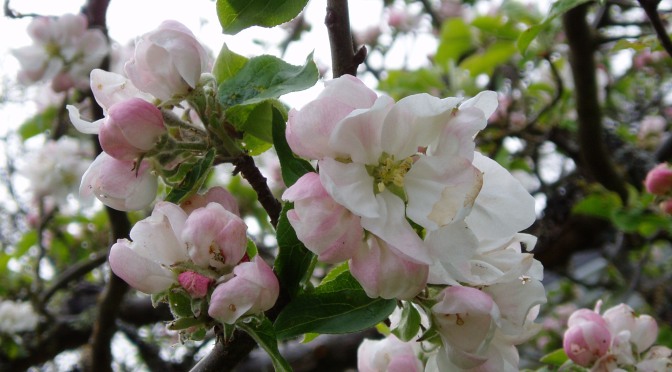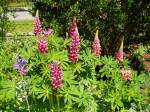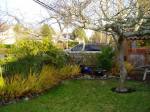This year C wants a good crop of apples, so we’re trying to do everything right.

STEP 1. – SPRAY
In February C mists the 2 apple trees with dormant spray in hopes of warding off the regular infestation of those tiny green worms. You know the ones: they float down from the Garry Oak & go crazy on the tasty apple leaves, before they burrow into the little apples.
It’s not easy to find a dry day in our West Coast winter for getting that job done. It’s even tougher to follow with a few dry days that allow the sulphur/oil to do its magic before the rains rinse it off .
STEP 2 – PARTNERS
The next challenge is pollination in spring. If it’s too windy, the blooms blow away. If it’s too rainy, the bees can’t get to the flowers to pollinate them… There’s not much we can do except cross our fingers for sunshine again.

And there’s also that concern over different apple varieties blooming at different times.
A Gravenstein blossom won’t turn into an apple unless it receives pollen from some other tree. Strange, eh? And Gravensteins are early bloomers – – hardly anything else is blooming then, so we rarely get much of a crop.
This year the weather was odd enough that the Gravenstein bloom was later & actually overlapped with the McIntosh bloom for a couple of days. Woo Hoo!

STEP 3 – PROTECT
By June the leaves fill in. I was disappointed to see signs they’d been feasted upon.

Sometimes we find tent caterpillars up in the branches. As a kid I thought fuzzy caterpillars were cute. Once I saw a whole mass of them coming out of their tent I was grossed out.
By this stage the fruit is starting to form, so we’re not willing to do any additional spraying. I prune the tent out of the tree, and seal the escape artists into a ziploc bag. How much energy can a tree put into apple production when its main energy collection system is under such attack? Bummer.

STEP 4 – THIN
When I first heard of thinning apples in spring, it sounded crazy! I’m always so excited to see all the new apples. Doesn’t it make sense to just let them ALL grow? But, especially after a successful pollination, even nature will cull a heavy load. Now I think about how many apples the tree can support…
and do we want many little apples?…
or a few really big apples?
This year I can already spot a few Gravenstein apples hiding in the foliage. The McIntosh are easier to spot. Before the summer solstice arrived, C cut out about 1/3 of the crop from the McIntosh. There’s so many up there, he figures he might just take 1/2 the crop to give the rest a chance to mature.

A couple of years ago I had culled 10 gallons of golf-ball-sized apples from the McIntosh. It wasn’t enough. By August we worried the limbs might break from the increasing weight. We used stakes to help support the branches!
STEP 5 – ENJOY
Now that summer is here, the chores get simpler:
Wait… and water.
If the summer continues with the lovely heat & sunshine of last weekend, I’m planning to put a lounge chair under the tree & enjoy the mist while the sprinklers do the work. 🙂
-30-
© SVSeekins and Garden Variety Life, 2013
















